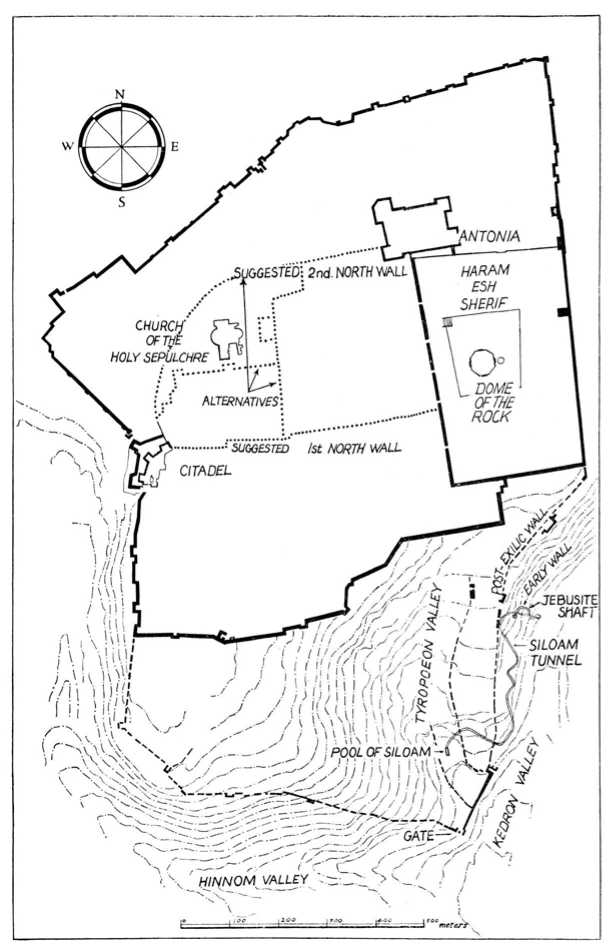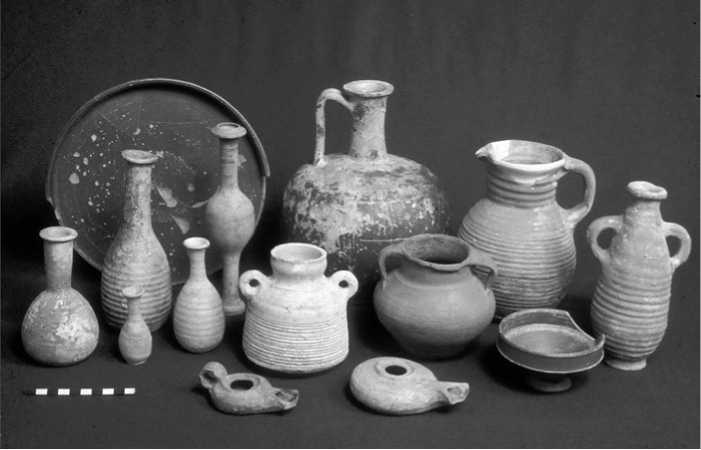Josephus tells us that by the time Jerusalem was destroyed by the Romans in 70 C. E., the city had expanded beyond the line of the First Wall. The suburbs to the north were enclosed by two successive fortification walls, called the Second Wall and the Third Wall. The First Wall was built by the Hasmoneans, following the line of the late Iron Age wall around the western hill. According to Josephus, the Third Wall — the latest and northernmost of the three walls — was begun by Herod Agrippa I and completed on the eve of the outbreak of the First Jewish Revolt. Although Josephus not does mention who built the Second Wall, most scholars believe that Herod is the best candidate because of the chronology (the First Wall is earlier and the Third Wall is later), and because there was so much growth and construction during his reign.
Josephus also describes the routes of the First, Second, and Third Walls. There is no controversy about the First Wall, which ran along the northern end of the western hill (just above the Transverse Valley), as indicated by archaeological remains. However, scholars disagree about the routes of the Second and Third Walls, with two main schools of thought: minimalists (represented mainly by British, German, French, and Australian archaeologists) and

7.19 Plan showing alternative lines for the second north wall of Jerusalem, according to the minimalists. From K. M. Kenyon, Digging Up Jerusalem (London: Ernest Benn Ltd., 1974), p. 233 Fig. 38. By permission of A&C Black Publishers.
Maximalists (represented mainly by Israeli archaeologists and American followers of William Foxwell Albright). The problem is that the landmarks that Josephus mentions along the Second and Third Walls disappeared long ago and their exact locations are unknown, although Josephus' description makes it clear that Third Wall enclosed a much greater area than the Second Wall.

7.20 Remains of the Third Wall.
According to the minimalists, the Third Wall is the same line marked by the north wall of the Old City today (in the center of which is the Damascus Gate), whereas the maximalists place the Third Wall to the north of the Old City.
The maximalists identify the Third Wall with the remains of a fortification wall that has been discovered about 1300 feet to the north of the Old City. This fortification wall — sometimes called the Meyer-Sukenik line after two Israeli archaeologists who excavated part of it — seems to be a convincing candidate for the Third Wall because it is built of Herodian-style stones. The minimalists have advanced no convincing explanation for the Meyer-Sukenik line if it is not the Third Wall. For example, they have proposed that perhaps it is a fourth line of wall built by the Jews at the time of the First Jewish Revolt, but Josephus mentions no such wall. Some have suggested that it was a circumvallation wall built by Titus when he besieged Jerusalem in 70 C. E., despite the fact that the towers project to the north, rather than south toward the city. In my opinion, although the Meyer-Sukenik line might be the Third Wall, it likely was built or rebuilt by Hadrian when he founded Aelia Capitolina (see Chapter 13).
The Second Wall is just as problematic as the Third Wall. According to the minimalists, the Second Wall reached only as far north as the area of the Antonia fortress whereas, according to the maximalists, it extended to the area of the Damascus Gate. In other words, according to the minimalists, the area of the Damascus Gate was part of the Third Wall, whereas according to the maximalists it was part of the Second Wall. Nevertheless, despite the lack of agreement and absence of unequivocal archaeological remains, both the minimalists and

7.21 Early Roman pottery including Eastern Sigillata A and Herodian oil lamps. Courtesy of Zev Radovan/BibleLandPictures. com.
Maximalists reconstruct a dogleg on the west side of the Second Wall, at exactly the same spot. This is because of reconstructions that take into account the location of the Church of the Holy Sepulcher, which, according to Christian tradition, enshrines the site where Jesus was crucified and buried. The Gospel accounts describe Jesus' crucifixion and burial as taking place outside the city wall. If the Church of the Holy Sepulcher enshrines the spot where Jesus was crucified and buried, it must lie outside the city wall at the time of Jesus' death. This wall would be the Second Wall (if we assume that it was built by Herod), because the Third Wall was not begun until after Jesus' death. Although the Church of the Holy Sepulcher was built about 300 years after the time of Jesus, most scholars accept the authenticity of the tradition (because it is one of the earliest Christian churches built anywhere — see Chapter 15). Therefore, to leave the Church of the Holy Sepulcher — the supposed site of Jesus' crucifixion and burial — outside the city wall at the time of Jesus' death, both minimalists and maximalists reconstruct the Second Wall with a dogleg (despite the lack of archaeological remains of a wall at this spot).
Material Culture Pottery
By the Herodian period, red-slipped dishes (Terra Sigillata) were the most popular table wares in the Roman world. Eastern Terra Sigillata was produced

7.22 Jerusalem painted bowls. Courtesy of Zev Radovan/BibleLandPictures. com.
At centers in the eastern Mediterranean (Phoenicia and Asia Minor) beginning around 125 B. C.E. Over the next century or two, centers in the western Mediterranean (Italy and Gaul) began manufacturing their own fine red ware (Western Terra Sigillata). The western products are distinguished by being made of fine, deep red clay covered with a glossy dark red slip, often applied over molded (relief) designs. Western Terra Sigillata is rare at sites in Palestine.
Although most of the local pottery is plain (undecorated), in the Herodian period a distinctive series of plates and shallow bowls was produced in the Jerusalem area. They have thin, hard-fired walls and are decorated with delicate geometric and floral designs. Because these Jerusalem painted bowls appear to imitate Nabataean ware, they are sometimes referred to as Pseudo-Nabataean ware.




 World History
World History









